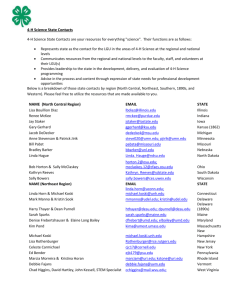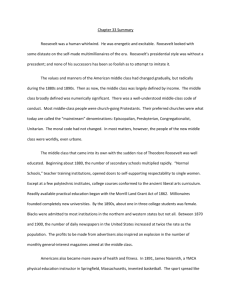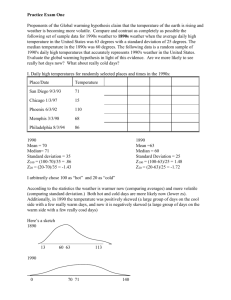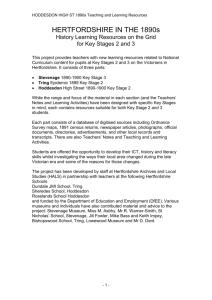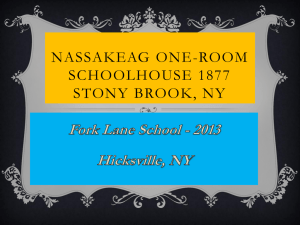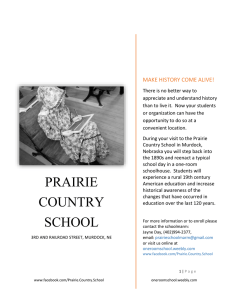school brochure - Murdock Museum
advertisement
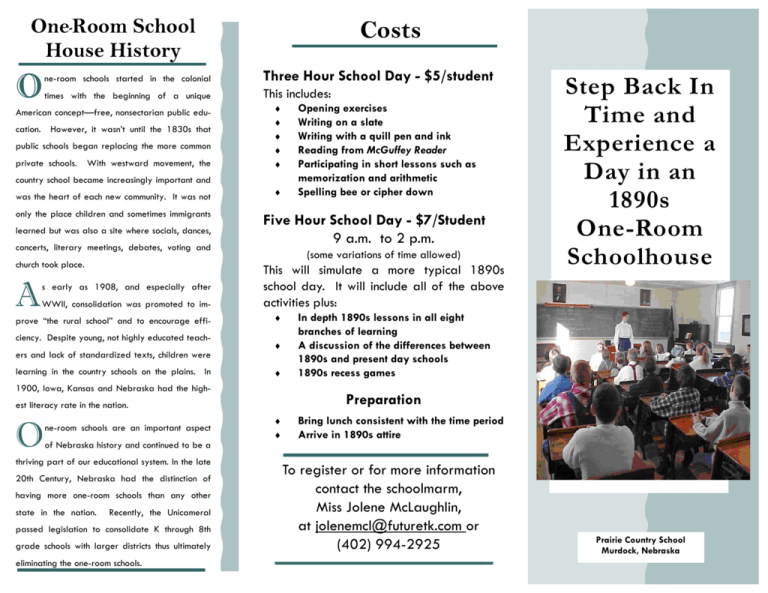
One-Room School House History o Costs ne-room schools started in the colonial Three Hour School Day - $5/student times with the beginning of a unique This includes: American concept—free, nonsectarian public education. However, it wasn’t until the 1830s that public schools began replacing the more common private schools. With westward movement, the ♦ ♦ ♦ ♦ ♦ country school became increasingly important and was the heart of each new community. It was not only the place children and sometimes immigrants learned but was also a site where socials, dances, concerts, literary meetings, debates, voting and church took place. A s early as 1908, and especially after WWII, consolidation was promoted to im- prove “the rural school” and to encourage efficiency. Despite young, not highly educated teach- ♦ Five Hour School Day - $7/Student 9 a.m. to 2 p.m. (some variations of time allowed) This will simulate a more typical 1890s school day. It will include all of the above activities plus: ♦ ♦ ers and lack of standardized texts, children were learning in the country schools on the plains. In ♦ 1900, Iowa, Kansas and Nebraska had the high- O In depth 1890s lessons in all eight branches of learning A discussion of the differences between 1890s and present day schools 1890s recess games Preparation est literacy rate in the nation. ne-room schools are an important aspect Opening exercises Writing on a slate Writing with a quill pen and ink Reading from McGuffey Reader Participating in short lessons such as memorization and arithmetic Spelling bee or cipher down Step Back In Time and Experience a Day in an 1890s One-Room Schoolhouse ♦ ♦ Bring lunch consistent with the time period Arrive in 1890s attire of Nebraska history and continued to be a thriving part of our educational system. In the late 20th Century, Nebraska had the distinction of having more one-room schools than any other state in the nation. Recently, the Unicameral passed legislation to consolidate K through 8th grade schools with larger districts thus ultimately eliminating the one-room schools. To register or for more information contact the schoolmarm, Miss Jolene McLaughlin, at jolenemcl@futuretk.com or (402) 994-2925 Prairie Country School Murdock, Nebraska 1890s School Days O Prairie School History Step Back in Time ne-room schoolhouses hummed with activities while children of all ages learned. The T eight common branches of learning (reading, writing, arithmetic, history, geography, grammar, Murdock Future Business Leaders of America (FBLA) along with incorporating morals into the curriculum. Chapter, that dream was realized in the spring of It wasn’t until the early 1900s that many one-room 2006. Through joint efforts, funds were raised and schools adopted the grade system, where students renovation was completed. The FBLA went on to win were passed from grade to grade until they classes were loosely organized into three general grades (beginners, intermediates and advanced) making it possible for farm boys to drop out to work on the farm and re-enter school without the embarrassment of being assigned to a beginning class. The school day consisted of calling groups of transform the Lion’s Club Building into a one- room schoolhouse. With the help of the Elmwood- orthography (spelling) and hygiene) were taught, graduated from eighth grade. Prior to that time, he Murdock Historical Society had a dream to T here is no better way to appreciate and remember history than to live it. Now your students or organization has the opportunity to do so at a convenient location. During your visit to the Prairie Country School in Murdock, you will step back into the 1890s and re-enact a typical school day. Students will have the opportunity to experience rural 19th Century American education and increase their historical awareness of the changes that have occurred in education over the last 100 years by: children to the teacher’s desk to read or recite, first place in the Community Service Project at the State Convention. For health and comfort reasons, the Society chose to put in the modern conveniences of heating and air conditioning and an indoor restroom. But these are not noticeable and do not distract from the 1890s look of the school with a raised platform in the front of the room, blackboard, wood stove, desks nailed to the floor, and even the ♦ Learning according to the rules of the 1890s typical pictures of Presidents Washington and ♦ Reading from McGuffey Readers Lincoln. The Prairie School building has an interesting ♦ Writing on slates history of its own. A highly anticipated time each ♦ Writing with quill pens and ink gymnasium for the Murdock High School basketball week was the cipher downs and spelling matches ♦ Participating in 1890s lessons of recitation, elocution, arithmetic exercises, spelling bees, geography, history, grammar and hygiene teams. It was built in 1906, by Modern Woodmen of while other children worked at their desks doing slate work, diagramming sentences, studying their McGuffey’s Readers, or working math problems on the blackboard. on Friday afternoons. I ♦ Playing 1890s recess games ♦ Singing songs of that period n addition, an online package is available at http:// www.murdockmuseum.org/ to prepare you for your visit to the school. It includes historical background information and guidelines to get ready for your 1890s school day, along with suggestions for clothing and lunches appropriate for the time period. School-day activities can also be customized for your group. Until 1924 it served as a America, it has been used as a meeting place and community center.

